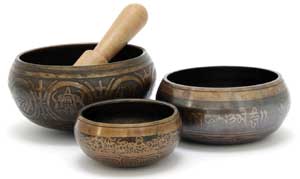Compiled by Photonics Spectra staff
Tibetan singing bowls have been used
in religious ceremonies to produce rich, beautiful sounds. Now physicists are filling
them with water and using them to quantify how droplets are propelled from the water’s
surface as the bowls are excited.
Generally composed from a bronze alloy containing nickel, tin,
copper, zinc, iron, silver and gold, Tibetan singing bowls are a type of standing
bell. They produce complex sounds when their rims are struck or rubbed with a leather-wrapped
or wooden mallet – much like the sound that floats out of a wine glass when
the edge is rubbed, and which inspired Benjamin Franklin to invent the glass harmonica.
A Tibetan singing bowl is easier to excite than a wine glass because its resonant
frequency is much smaller.
 The singing properties of the bowl were used by scientists at
Université de Liège and MIT to investigate how liquids interact with solid
materials – a situation that arises in many engineering applications, including
wind-loading of buildings and bridges.
The singing properties of the bowl were used by scientists at
Université de Liège and MIT to investigate how liquids interact with solid
materials – a situation that arises in many engineering applications, including
wind-loading of buildings and bridges.
When the fluid-filled Tibetan bowl is rubbed, the slight changes
in its shape disturb the surface at the water’s edge, generating waves. When
these changes are sufficiently large, the waves break, causing droplets of water
to be ejected. These new findings could benefit processes where droplet generation
plays a significant role, such as fuel injection and perfume sprays.
To quantify how the droplets were formed, ejected, accelerated
and bounced on the surface of the fluid in the bowl, the researchers used a Vision
Research Phantom high-speed video camera. They measured the droplets from the images
captured with the camera. To generate the droplets, they set up a loudspeaker adjacent
to the bowl, which then emitted sound at specific frequencies. Once the sound hit
the resonant frequency of the bowl, it generated waves, allowing the scientists
to capture images of ejected droplets.
The study was published in the July 1 issue of Nonlinearity (doi:
10.1088/0951-7715/24/8/R01).